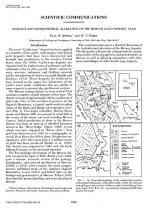Добрый день, Коллеги. Важное сообщение, просьба принять участие. Музей Ферсмана ищет помощь для реставрационных работ в помещении. Подробности по ссылке
Geology and hydrotermal alteration of the Mercur gold deposit, Utah
The term "Carlin-type" deposit has been applied to a number of low-grade, sedimentary rock-hosted gold deposits that have been discovered and brought into production in the western United States since the 1960s. Carlin-type deposits are characterized by replacement of carbonate and silty carbonate rocks by silica, pyrite, barite, various arsenic, mercury, antimony, and thallium minerals and by introduction of micron-size gold (Radtke and Dickson, 1974). These deposits are believed to have formed in the upper few kilometers of the earth's crust under conditions that are similar in some respects to present-day geothermal systems.
The Mercur mining district in west-central Utah contains a number of gold deposits of this type. The district is located approximately 90 km southwest of Salt Lake City in the southwest portion of the Oquirrh Mountains, a typical north-south-trending range of the Basin and Range physiographic province (Fig. 1). Two major orebodies, Mercur-Sacra-mento and Marion Hill, are present in small hills in the center of the steep, east-west-trending Mercur Canyon. Initial production of silver in the Mercur district was from an interval of silicified limestone known as the "Silver ledge" (Spurr, 1895), a term which was later changed to "Silver chert." Fine gold was discovered in 1883 in a stratigraphic interval 30 m above the Silver chert. Production terminated in 1917 after more than 1.2 million ounces of gold had been produced (Butler et al., 1920). The district was reopened in 1983 with the Getty Mining Company as the principal operator.
The first geologic description of the Mercur district was given by Spurr (1895). Butler et al. (1920) gave a concise, accurate review of the geology, stratigraphy, and mineral production at Mercur. Gilluly's (1932) work remains the most comprehensive published study of the southern Oquirrh Mountains. Lenzi (1973) published data on the background geochemistry at Mercur. Tafuri (1976) described the general geology and mineralization at Mercur.
This communication gives a detailed discussion of the hydrothermal alteration of the Mercur deposits. The discussion will provide a framework for continuing studies of the paragenesis and geochemistry at Mercur as well as allowing comparison with alteration assemblages of other Carlin-type deposits.




